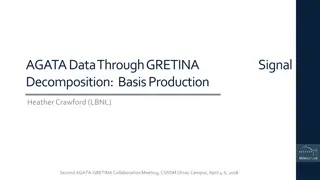Update on Cross-Border M&A in Corporate/International Taxation
This update covers key discussions on cross-border M&A in corporate and international taxation, including PTEP and Section 961 Basis implications, IRS Notice 2024-16, and regulations to be issued for covered inbound transactions. The content delves into intricate scenarios involving basis adjustment
2 views • 67 slides
Research Program on Spin Polarized Nuclei in Fusion Plasmas
Examination of spin polarized fuel in fusion plasmas to enhance energy production efficiency. Planned experiments aim to measure the lifetime of polarized nuclei for optimized fusion reactions. Key aspects include depolarization mechanisms, neutral beam heating, and fueling techniques with pellets.
1 views • 36 slides
Understanding Polarized Light Microscopy in Instrumental Analysis
Microscopes are essential tools for examining small details in samples. Polarized Light Microscopes (PLM) use polarized light to enhance image quality and study birefringent materials. This article covers the basics of microscopes, the principles of PLM, the differences between PLM and LM, and the a
2 views • 16 slides
Cultivating Egoence in a Polarized World Presentation
Living consciously requires egoence, the awareness of oneself in relationship to the whole. Through methods like spiritual practice, meditation, and journaling, one can nurture egoence to support a conscious life amidst constant change in a polarized world. The presentation explores the concept of e
0 views • 10 slides
Harmonisation of Substantive Criminal Law in the EU
The Treaty of Lisbon serves as a legal foundation for the harmonisation of substantive criminal law within the European Union. It establishes the basis for judicial cooperation, mutual recognition of judgments, and approximation of laws across Member States. The treaty allows for the establishment o
2 views • 60 slides
Simulating Basic PNR and PA Systems: A Practical Approach
Explore how to effectively simulate basic Polarized Neutron Reflectometry (PNR) and Polarization Analysis (PA) systems to enhance proposal submissions and experiment success. Learn about the NIST PNR calculator, useful websites for calculations, and key elements in simulating data for analysis.
0 views • 16 slides
Understanding Aging Process from a Biochemical Perspective
Biochemistry and Molecular Biology play crucial roles in understanding the aging process, focusing on the biochemical basis of life, the basis of health, major causes of diseases, and theories of aging. Aging is described as the accumulation of damage due to reactive oxygen species, with theories en
2 views • 11 slides
Optical Properties of Optically Active Compounds
Circular dichroism and optical rotatory dispersion are important techniques for studying the optical properties of optically active compounds. Circular dichroism measures the differential absorption of left and right circularly polarized light components, while optical rotatory dispersion studies th
0 views • 17 slides
Approval and Validation Updates for NR MIMO OTA in 3GPP TSG-RAN.WG4 Meeting
The 3GPP TSG-RAN.WG4 Meeting discussed approval for the NR MIMO OTA workplan, addressed FR2 blocking issues, and emphasized the use of polarized antenna models. Updates were made to the power validation procedure and gNB beams usage criteria for FR1 MIMO OTA channel model validation. Collaboration w
1 views • 8 slides
Financial Accounting IFRS Learning Objectives
This educational material covers Chapter 3 of the Financial Accounting IFRS 3rd Edition by Weygandt, Kimmel, and Kieso. It delves into topics such as adjusting the accounts, time period assumption, accrual basis of accounting, fiscal and calendar years, accrual versus cash-basis accounting, and more
0 views • 20 slides
Accounting Basis Diagnostic Tool for NPOs and Funders
This diagnostic tool focuses on cash, modified cash, and accrual basis accounting for Non-Profit Organizations (NPOs) and funders. It explains the impact of accounting basis decisions and how to utilize the tool effectively. Designed for NPOs and funders, it helps in understanding, negotiating, and
0 views • 39 slides
Understanding fMRI 1st Level Analysis: Basis Functions and GLM Assumptions
Explore the exciting world of fMRI 1st level analysis focusing on basis functions, parametric modulation, correlated regression, GLM assumptions, group analysis, and more. Dive into brain region differences in BOLD signals with various stimuli and learn about temporal basis functions in neuroimaging
0 views • 42 slides
Understanding Basis and Dimension in Linear Algebra
Basis and dimension are fundamental concepts in linear algebra. A basis is a set of vectors in a vector space that allows us to represent any vector by multiplying and adding the basis vectors. The dimension of a vector space is the number of elements in its basis. Linear independence, spanning sets
0 views • 13 slides
Understanding Basis and Dimension in Linear Algebra
Basis and dimension are fundamental concepts in linear algebra. A basis is a set of vectors that can represent any vector in a given space through linear combinations. The dimension of a vector space is determined by the number of elements in its basis. Linear independence, spanning, finite-dimensio
5 views • 13 slides
Nuclear Physics Research Highlights: Neutron Stars, Nuclear EOS, and Pb Isotope Studies
Explore cutting-edge research in nuclear physics, including experiments on pion ratios and Pb isotope radius measurements, neutron star observations, neutron density distributions of Pb isotopes, and polarized proton beams at Osaka University. Learn about the analysis of realistic point proton densi
0 views • 26 slides
Study of a Polarized Internal Target at the LHC: General Requirements and Preliminary Results
The LHCb Spectrometer at the Large Hadron Collider is exploring the design of a polarized gas target (PGT) similar to the HERMES target in the VELO alcove. The project aims to improve precision in luminosity measurements for antiproton production in colliding bunches. The new SMOG2 system with addit
0 views • 21 slides
Understanding Quark Sivers Function and Spin-Dependent Odderon
Quark Sivers function, a key aspect in quantum chromodynamics, plays a role in capturing orbital angular momentum and spin-orbit coupling. Spin-dependent Odderon, an elusive three-gluon exchange, contributes to cross sections in high-energy collisions. Small-$? TMDs from polarized Wilson lines provi
0 views • 17 slides
Understanding Basis Functions and Hemodynamic Response Functions in fMRI Analysis
This content discusses the use of basis functions, parametric modulation, and correlated regressors in the first-level analysis of fMRI data processing. It delves into the concept of temporal basis functions for modeling complex functions of interest, such as the canonical hemodynamic response funct
1 views • 26 slides
Understanding Electron Correlation and Basis Sets in Molecular Calculations
Polarized basis sets describe the electron density polarization in atoms and molecules to improve accuracy in computed geometries and frequencies. Diffuse basis sets are recommended for calculating electron and proton affinities. Electron correlations account for electron interactions in molecular c
0 views • 8 slides
John Brown's Role in Escalating Tensions Towards the Civil War
Explore John Brown's pivotal role in the lead-up to the Civil War through his radical abolitionist actions, including the violent events in Bleeding Kansas and his infamous raid on Harper's Ferry. Brown's staunch anti-slavery stance and militant tactics further polarized the nation on the issue of s
0 views • 9 slides
Understanding Nucleon Spin Decomposition and Proton Spin Problem
Explore the complex realm of nucleon spin decomposition and the enigmatic proton spin problem, delving into concepts like orbital angular momentum, quarks and gluons' helicity, and longitudinal double spin asymmetry in polarized deep inelastic scattering. Learn about the spin crisis, gluon polarizat
0 views • 26 slides
Measuring Proton and Antiproton Polarization at U70 Accelerator
Absolute polarimeters are described for the beam channel at U70 Accelerator in Russia, focusing on transporting polarized proton and antiproton beams. Various polarimeters are discussed for measuring proton and antiproton polarization, including diffraction and interference-based techniques. The exp
0 views • 37 slides
Understanding Basis Set Generation in Computational Chemistry
Detailed explanation and control over defining basis set functions, species labels, number of shells, basis set generation procedures, and solving the Schrödinger equation for ion generation. Explore schemes for generating multiple basis sets and the impact of extra charge on orbital localization i
0 views • 17 slides
Examining Two Polarizing Court Cases: Arbery Murder Trial and Rittenhouse Acquittal
Two high-profile court cases - the conviction of three men for the murder of Ahmaud Arbery in Georgia and the acquittal of Kyle Rittenhouse for fatal shootings in Kenosha, Wisconsin - have sparked debates on self-defense, citizen's arrests, and the role of video evidence. The cases exemplify the int
0 views • 5 slides
Basis Production Procedure for AGATA through GRETINA Signal Decomposition
This presentation outlines the detailed procedure for generating basis signals in the context of AGATA data processed through GRETINA signal decomposition. It covers the generation of pristine basis signals, superpulse analysis, and the creation of cross-talk corrected basis files. The process invol
0 views • 19 slides
Functional Approximation Using Gaussian Basis Functions for Dimensionality Reduction
This paper proposes a method for dimensionality reduction based on functional approximation using Gaussian basis functions. Nonlinear Gauss weights are utilized to train a least squares support vector machine (LS-SVM) model, with further variable selection using forward-backward methodology. The met
0 views • 23 slides
Electron Beam Generation and Cathode Research at HERACLES Facility
Research at the HERACLES facility focuses on electron beam generation and cathode development for high-current applications. Photocathodes play a crucial role in providing low energy spread beams required for processes like FEL-lasing. GaAs emerges as a promising candidate for spin-polarized electro
0 views • 33 slides
Challenges and Considerations in Electron-Ion Collider Detector Development
Exploring the development of detector systems for Electron-Ion Colliders (EIC) involves addressing various issues such as detector acceptance for low Q2 and high Q2, unique beam characteristics, and the need for specialized components like bend magnets and polarimeters. Key considerations include po
0 views • 16 slides
Achieving High Average Beam Polarization in Particle Colliders
Detailed discussion on achieving high average beam polarization in particle colliders like CEPC, focusing on longitudinal polarized colliding beams, beam polarization requirements, basic formulas, and strategies for maintaining beam polarization during physics runs. Emphasis on scenarios involving s
0 views • 16 slides
Understanding B-Spline Curves in Computer Graphics
Exploring the advantages of B-spline curves over Bezier curves, this content delves into the representation, calculation of basis functions, and properties of B-spline curves. The discussion includes issues with Bezier curve representation, local control in B-spline curves, and the subdivision of th
0 views • 11 slides
Advancements in Neutron Cooling Techniques and Paramagnetic Systems
The presentation discusses cascaded cooling of neutrons and Namiot's proposal for phononless cooling to low temperatures using polarized deuterons. It explores inelastic scattering cross-sections, candidate paramagnetic systems, and excitations in O2. Additionally, it covers rate constants, superflu
0 views • 11 slides
Component Design Basis Inspection (CDBI) Program Overview
The Component Design Basis Inspection (CDBI) program ensures plant components are maintained within their design basis and monitors their capability to perform essential functions. Insights reveal the inspection frequency, estimated hours, fees, team composition, and inspection schedule. The baselin
0 views • 18 slides
Understanding Basis of a Set in Linear Algebra
A basis for a vector space V is an independent generating set. There are intuitive ways to confirm if a set is a basis, such as checking if it is independent and generates V. The dimension of V helps determine if a subset is a basis. Examples and methods like the extension theorem are explored to fi
0 views • 6 slides
Unraveling Time-Slices of Events in SPD Experiment at the 10th International Conference
In the context of the SPD experiment within the NICA project, the challenge lies in processing vast amounts of data efficiently to extract valuable events. The SPD experiment aims to study the spin structure of nucleons through polarized proton collisions. Approaches like predictive modeling, interp
0 views • 13 slides
Investigation of Spin Observables in Elastic pp and p(bar)p Scattering at SPASCHARM Program
Measurements of spin observables in elastic pp and p(bar)p scattering at 16 GeV will be conducted at the SPASCHARM program using a unique setup with polarized proton and antiproton beams. The experiment aims to extend the energy range for spin studies and compare elastic scattering in pp and p(bar)p
0 views • 24 slides
Enhance Your Vision with Progressive Lens Packages
Explore the range of progressive lens packages offering digital lenses with unparalleled accuracy and clarity. Upgrade your vision with features like wider vision channels and HD-quality optical performance. Additional assets like polarized, non-glare, and Light-Reactive lenses provide optimal visio
0 views • 4 slides
Evolution of 3D Films: From Stereoscopic Headsets to Polarized Glasses
Explore the fascinating history of 3D films, starting from the stereoscopic headsets in 1894 to the polarization technique in the 1940s. Discover how 3D films provide a unique visual experience with depth perception and learn about the evolution of technology to create immersive 3D effects. Delve in
0 views • 28 slides
Review of Positron Source R&D for Linear Colliders by R. Chehab
Intense positron sources, whether polarized or not, are vital for future e+e- linear colliders. This review covers different types of e+ sources, including circularly polarized photons and methods to obtain polarized positrons. Techniques such as helical magnetic undulators and Compton backscatterin
0 views • 26 slides
Comparing Polarized Gas Targets at LHC and HERA for Spin Studies
The comparison between Polarized Gas Targets (PGT) at the Large Hadron Collider (LHC) and HERA for spin studies is discussed. Key considerations such as beam-induced depolarization, beam parameters, and design aspects are highlighted. The importance of using a polarized gas target similar to HERMES
0 views • 15 slides
Study on THz Wave Scattering from Slightly Rough Surfaces: Interference and Implications
Overview of polarized THz wave scattering from slightly rough surfaces such as wooden tables and walls. The document discusses the induced interference between short-distance THz links and presents a model of electromagnetic wave scattering with examples of experimental and numerical results. Potent
0 views • 17 slides







































